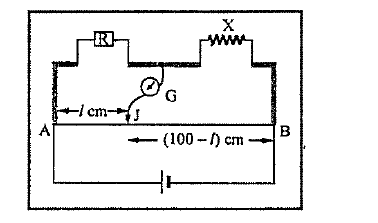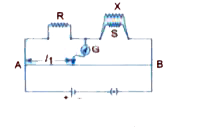A resistance R = 4Ω is connected to one of the gaps in a metre bridge which uses a wire of length 1m. An unknown resistance X > 4Ω is connected in the other gap as shown in the figure. The balance point is noticed at ‘l’ from the positive end of the battery. On interchanging R and X it is found that the balance point further shifts by 20cm away from end A. Neglecting the end correction calculate the value of unknown resistance X used.
From ‘metre bridge’ formulaOn interchanging R and X the balance point is obtained at a distance l + 20cm from end A so
Related Solutions
A resistance is connected to one of the gaps in a metre bridge, which uses a wire of length 1m. An unknown resistance X is connected in the other gap as shown in the figure. The balance point is noticed at 'l' from the positive end of the battery. On interchanging R and X, it is found that the balance point further shifts by 20 cm (away from end A). Neglecting the end correction, calculate the value of unknown resistance X used.
 View Solution
View SolutionConsider a metre bridge whose length of wire is 2m. A resistance of 10 is connected across one gap of the meter bridge and an unknown resistance is connected across the other gap. When these resistances are interchanged, the balance point shifts by 50 cm. What is the value of the unknown resistance?
View SolutionA resistance of is connected in one gap of a metre bridge and in the other gap. Calculate the position of the balancing point.
View SolutionTwo equal resistance are connected in the gaps of a metre bridge. If the resistance in the left gap is increased by the balancing point shift
View SolutionTwo equal resistance are connected in the gaps of a metre bridge. If the resistance in the left gap is increased by the balancing point shift
View SolutionA resistance of 2Omega is connected across one gap of a metre-bridge (the length of the wire is 100 cm) and an unknown resistance, greater than 2Omega , is connected across the other gap. When these resistances are interchanged, the balance point shifts by 20 cm. Neglecting any corrections, the unknown resistance is :
View SolutionA resistance of is connected across one gap of a metre-bridge (the length of the wire is 100 cm) and an unknown resistance, greater than , is connected across the other gap. When these resistances are interchanged, the balance point shifts by 20 cm. Neglecting any corrections, the unknown resistance is
View SolutionA resistance of is connected across one gap of a metre-bridge(the length of the wire is 100 cm) and an unknown resistance, greater than , is connected across the other gap. When these resistances are interchanged, the balance points shifts by 20 cm. Neglecting any corrections, the unknown resistance is
View SolutionA resistance of 2Omega is connected across one gap of a metre-bridge (the length of the wire is 100 cm) and an unknown resistance, greater than 2 Omega , is connected across the other gap. When these resistances are interchanged, the balance point shifts by 20 cm. Neglecting any corrections, the unknown resistance is
View SolutionA resistance of 2 Omega is connected across one gap of a metre bridge (the length of the wire is 100cm) and an unknown resistance greater than 2 Omega , is connected across the other gap. When these resistances are interchanged, the balance point shifts by 20 cm neglecting any corrections, the unknown resistance is
View SolutionIn a metre-bridge experiment, when the resistances in the gaps in the gaps are interchanged, the balance-point did not shift at all. The ratio of resistances must be
View SolutionIn a metre bridge, metal wire is connected in the left gap, standard resistance is connected in the right gap and balance point is found. If the metal wire in the left gap is heated, the balance point
View SolutionIn a meter bridge when the resistance in the lift gap, is and an unknown resistance in the right gap, the balance point is obtained at 40 cm from Zero end. On shunting the unknown resistance with find the shift of the balance point on the bridge.
View SolutionAn unknown resistance is connected in series with a resistance of 10 ohm. This combination is connected to one gap of a metre bridge, while other gap is connected to another resistance The balance point is at 50 cm. Now, when the 10 ohm resistance is removed, the balance point shifts to 40 cm. Then, the value of is:
View SolutionAn unknown resistance R1 is connected in series with a resistance of 10 ohm. This combination is connected to one gap of a metre bridge, while other gap is connected to another resistance R2 . The balance point is at 50 cm. Now, when the 10 ohm resistance is removed, the balance point shifts to 40 cm.Then, the value of R1 is
View SolutionAn unknown resistance is connected in series with a resistance of . This combinations is connected to one gap of a metre bridge while a resistance is connected in the other gap. The balance point is at 50 cm. Now, when the resistance is removed the balance point shifts to 40 cm. The value of is : (in ohm)
View SolutionTwo resistances are connected in two gaps of slide wire bridge. The balance point is at 40cm from left end. A resistance X is connected in series with smaller resistance R and balance point shifts to 40cm from right end. What is the value of X if R is 4Omega ?
View SolutionTwo resistances are connected in two gaps of slide wire bridge. The balance point is at 40 cm from left end. A resistance X is connected in series with smaller resistance R and balance point shifts to 40 cm from right end. What is the value of X if R is ?
View SolutionWhen un known resistance and a resistance of are used in the left and right gaps of a meter bridge, the balance point is 50cm. the shift in the balance point if a resistance is now connected parallel to the resistor in right gap ______
View Solution(i) State the principle of working of a metre bridge.
(ii) In a metre bridge balance point is found at a distance with resistances R and S as shown in the figure.
When an unknown resistance X is connected in parallel with the resistance S, the balance point shifts to a distance l. Find the expression for X in terms of and S.
 View Solution
View Solution
